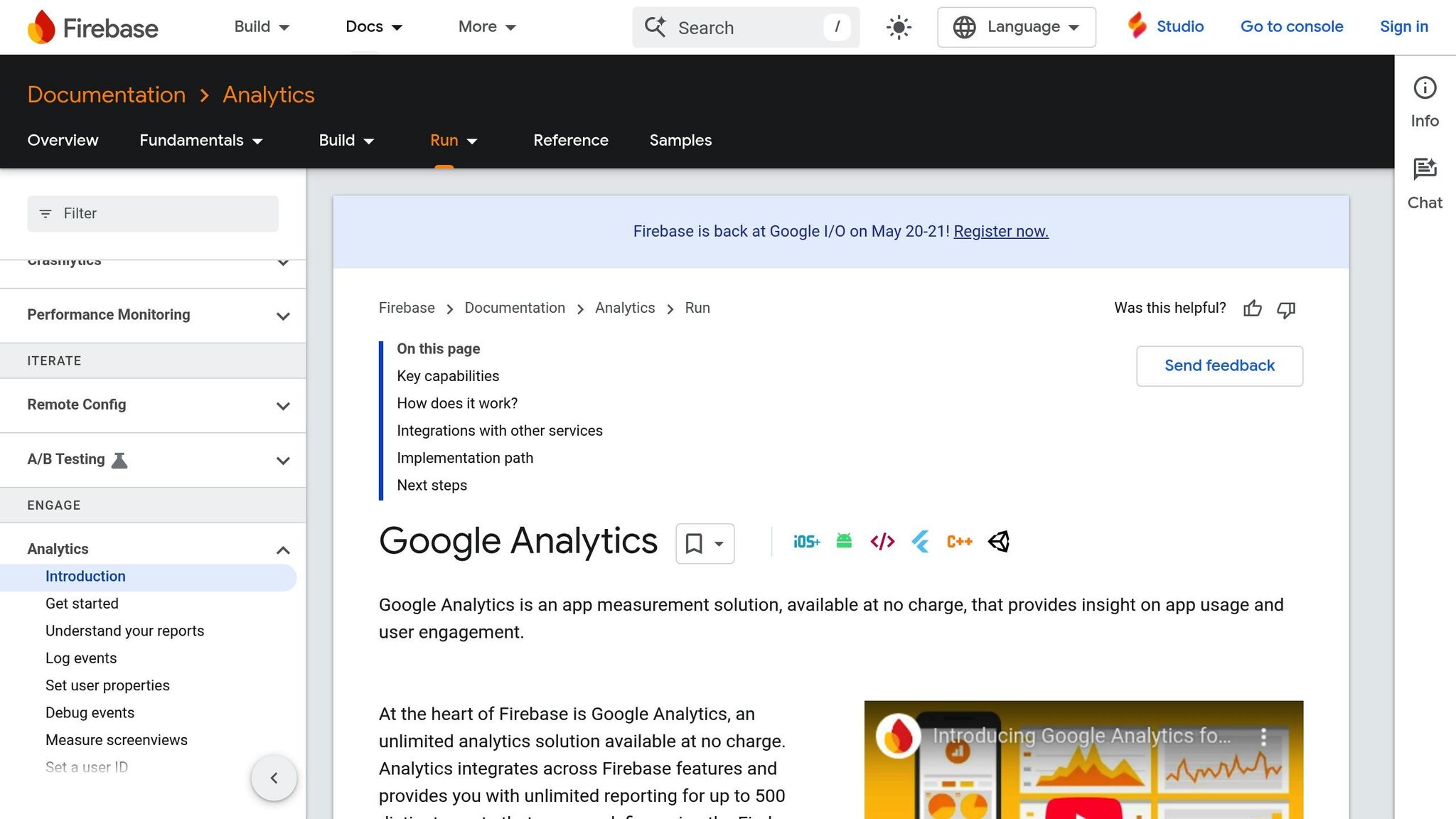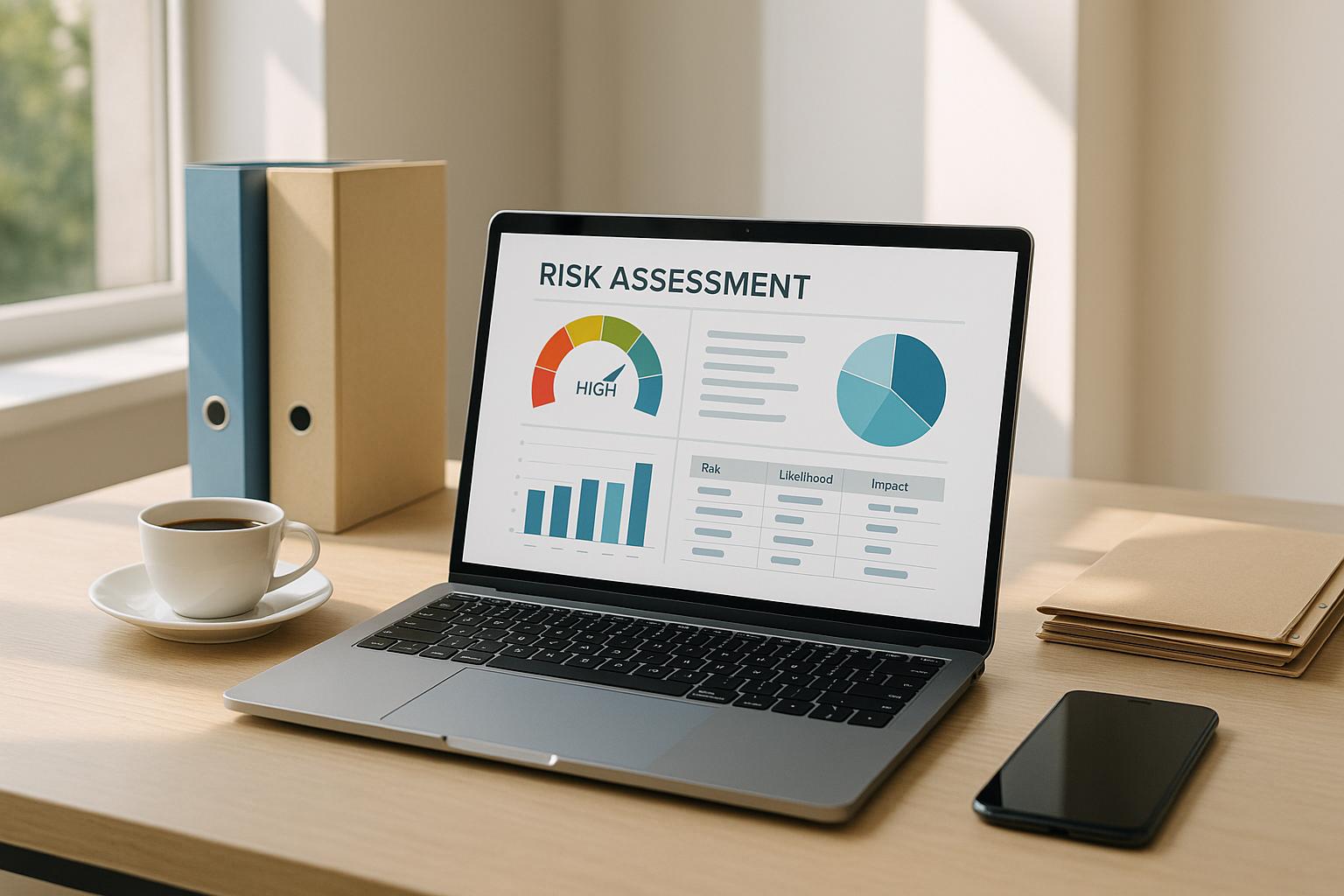Real-time user tracking lets you monitor how users interact with your app as it happens. This helps you improve the user experience, fix issues faster, and make better decisions about features and marketing. Here's what you need to know:
-
Benefits:
- Spot and fix problems immediately (like crashes or slow load times).
- Improve user experience by identifying and fixing pain points.
- Use data to create personalized campaigns and boost engagement.
- Track key metrics like session duration, crash rates, and conversions.
- How to Get Started:
-
Key Metrics to Track:
- Engagement: Session duration, feature usage.
- Performance: Crash rates, load times.
- Conversions: Signups, purchases.
- User Journeys: Navigation patterns, drop-off points.
-
Pro Tips:
- Use clear event names (e.g.,
purchase_complete). - Focus on privacy compliance (GDPR, CCPA).
- Start with free tools like Firebase, then scale up as needed.
- Use clear event names (e.g.,
Real-time tracking turns raw data into actionable insights, helping you improve your app and grow your business.
Real-Time User Tracking Fundamentals
Definition and Purpose
Real-time user tracking captures and analyzes mobile app interactions as they happen, allowing businesses to respond quickly to user needs and technical problems. This process uses SDKs to monitor interactions like screen taps and feature usage. The instant feedback helps companies take swift, informed actions.
Key Mobile App Metrics
To make the most of real-time tracking, focus on metrics that directly influence app performance:
| Metric Category | Key Measurements | Business Impact |
|---|---|---|
| User Engagement | Session duration, screen time, feature usage | Improves app flow and highlights essential features |
| Technical Performance | Load times, crash rates, API response times | Quickly resolves technical issues |
| Conversion Events | Purchase completions, sign-ups, feature adoption | Boosts revenue and user growth |
| User Journey | Screen flow, drop-off points, navigation patterns | Pinpoints areas causing user friction |
These metrics provide actionable insights, helping businesses refine their apps and make smarter marketing decisions.
Impact on App Success
Real-time tracking plays a major role in improving app performance. Here's how:
Quick Problem Fixes: Developers can detect and resolve issues immediately, ensuring the app remains stable and users stay happy.
Better User Experience: By analyzing user behavior in real time, teams can identify and fix pain points quickly. This allows for constant improvements to the app's design and functionality.
Smarter Marketing: Real-time analytics enable personalized messaging and targeted campaigns based on current user behavior. This approach is becoming more popular as companies shift to AI-driven analytics and move away from cookie-based tracking.
The real strength of real-time tracking lies in turning raw data into actionable insights. Modern tools focus on clear data visualization and instant insights, helping teams make quicker, more informed decisions for both app development and marketing.
Selecting User Tracking Tools
Tool Selection Requirements
When choosing tracking tools, focus on features like fast data processing (under 1 second), native SDK compatibility, detailed event tracking, scalability, compliance with privacy laws, and easy integrations. Here's a breakdown of key requirements:
| Requirement | Description | Impact |
|---|---|---|
| SDK Compatibility | Works natively with iOS and Android platforms | Simplifies development efforts |
| Data Granularity | Tracks events at a detailed level | Supports in-depth user behavior analysis |
| Scalability | Handles growing user activity and events | Avoids system slowdowns |
| Privacy Compliance | Adheres to GDPR, CCPA, and US regulations | Ensures legal and ethical operations |
| Integration Options | Connects smoothly with existing systems | Improves data flow and efficiency |
These criteria help narrow down the best tracking tools tailored to your app's needs.
Common Tracking Solutions
Different app types benefit from specialized tracking tools. For example, gaming apps focus on gameplay metrics, e-commerce apps prioritize purchase behavior, and subscription apps monitor recurring revenue.
E-commerce Apps
Adobe Analytics excels in tracking purchase funnels and cart abandonment. It provides real-time insights, enabling businesses to adapt quickly to shopping trends.
Gaming Apps
GameAnalytics is ideal for gaming apps, offering features like player retention heatmaps and real-time metrics, which are crucial for high-intensity gameplay.
Subscription Apps
RevenueCat specializes in tracking subscriptions and in-app purchases. It delivers real-time data on conversion rates and revenue, making it a strong choice for apps relying on recurring payments.
"Apps scaling beyond 5M MAUs often require custom enterprise plans averaging $25,000+ per year", according to an IDC 2025 Analytics Survey. "92% of enterprises now prioritize sub-10-second latency in their analytics dashboards."
Marketing Analytics Tools Directory Guide
After identifying your app's needs and exploring common solutions, the Marketing Analytics Tools Directory can help you compare tools based on use case, cost, and integration options.
Advanced Search Filters
- Filter tools by real-time tracking capabilities
- Compare pricing plans
- Assess integration compatibility
The directory also includes step-by-step setup guides. For example, CleverTap can be implemented in under 45 minutes.
Duolingo cut integration costs by 40% by using Segment to consolidate its analytics tools. For early-stage apps, consider starting with free options like Firebase, which supports up to 500 events per second. As your user base grows, you can transition to more robust solutions.
Setting Up Real-Time Tracking
SDK Installation Steps
To start, choose the right SDK for your app's platform. For iOS apps, you can use tools like CocoaPods or Swift Package Manager. For Android, you’ll need to set it up through Gradle.
- Add Dependencies
Here’s an example for Android using Gradle:
dependencies {
implementation 'com.mixpanel.android:mixpanel-android:5.8.7'
implementation 'com.amplitude:android-sdk:2.34.0'
}
- Initialize the SDK
For iOS, you can initialize the SDK with the following Swift code:
import Analytics
let configuration = Configuration(writeKey: "YOUR_WRITE_KEY")
Analytics.setup(with: configuration)
- Set Up Permissions
Add the necessary privacy permissions to your Android manifest or iOS info.plist. Keep in mind, iOS 14.5+ requires App Tracking Transparency.
Once the SDK is installed, you’ll be ready to configure event tracking to monitor user interactions.
Event Tracking Setup
After the SDK is in place, decide which user actions you want to track in your app. Below is a table to help prioritize key events:
| Event Category | Example Events | Tracking Priority |
|---|---|---|
| Navigation | Screen views, menu clicks | High |
| Engagement | Time spent, feature usage | Medium |
| Conversion | Purchases, signups | Critical |
| Error States | App crashes, API failures | High |
When setting up event tracking:
- Use clear, descriptive event names (e.g.,
verb_noun) and include user attributes like device type, app version, or preferences for deeper insights. - Log errors such as crashes or API failures to quickly identify and resolve issues.
Testing Your Setup
Before rolling out your tracking setup, test it thoroughly to ensure everything works as expected.
- Debug Mode Testing
Enable debug logging in your analytics SDK to confirm events are firing correctly. For example:
Analytics.debug(true)
-
Data Validation
Use tools like real-time event viewers, debug consoles, or analytics dashboards to verify the data being collected. -
Common Test Scenarios
Run tests for typical user actions, including:- Registration processes
- Purchase flows
- Navigation within the app
- Handling of errors or crashes
To ensure you’re capturing accurate data, test across different devices and operating system versions. This will help identify any potential issues before going live.
sbb-itb-5174ba0
Using Real-Time Data
Reading Analytics Dashboards
- Create Custom Views: Design dashboards tailored to different team needs. For instance, product managers might focus on tracking feature adoption, while developers may zero in on app stability metrics.
- Track Key Metrics: Keep an eye on critical performance indicators such as daily active users (DAU), session duration, navigation paths, crash rates, and feature usage for actionable insights.
- Set Up Alerts: Configure notifications for key metrics. For example, you can receive alerts if crash rates spike or session durations drop below expected levels.
These insights allow teams to respond quickly to user challenges.
Fixing User Issues
1. Spot Problem Areas
Use tools like session replays and heatmaps to find screens with high exit rates. Error logs can also pinpoint technical issues needing immediate attention.
2. Rank Fixes by Priority
Once you’ve identified the issues, prioritize them. Focus first on problems affecting a large number of users or those causing severe disruptions. Less critical issues can be addressed afterward.
3. Roll Out Solutions
Implement fixes and measure their impact using A/B testing and user feedback. Compare metrics before and after the changes to confirm improvements.
Improved performance data can then be leveraged to further refine user experiences.
Increasing User Engagement
Real-time data can also help improve user retention and satisfaction.
Personalization Tactics:
- Tailor content and send targeted notifications during peak usage times.
- Adjust feature visibility based on individual user preferences.
Boosting Engagement:
- Pinpoint the best times to communicate with users.
- Re-engage inactive users with personalized campaigns.
- Use feature adoption trends to guide future updates and enhancements.
Performance Tracking:
- Monitor load times across devices and different network conditions.
- Keep an eye on API response times.
- Analyze navigation patterns to refine the app’s usability and overall experience.
Firebase Analytics for iOS: Track User Behavior With Data ...

Summary
Real-time tracking requires precise SDK integration, proper event setup, and thorough testing to work effectively.
Here’s what makes a tracking system successful:
Tool Selection and Setup
- Choose tools that are compatible with your platform.
- Ensure the SDK is integrated correctly.
- Use clear and consistent event names for better organization.
Data Analysis and Action
- Keep an eye on real-time dashboards to track user behavior.
- Pinpoint areas where users face challenges.
- Turn raw data into actionable changes to improve performance.
Performance Optimization
- Monitor metrics like daily active users (DAU), session length, and crash rates.
- Study how users navigate your app to identify trends.
- Make changes that improve usability and overall user experience.
These steps work together to create a strong tracking system. By combining these strategies, you can turn data into meaningful improvements. Regular monitoring helps transform insights into better experiences for your users.
"Real-time user tracking provides insights into user behavior, helps identify key growth levers, and assesses churn risks", notes industry experts at the Marketing Analytics Tools Directory.
FAQs
What should I consider to ensure privacy compliance when setting up real-time user tracking in apps?
When implementing real-time user tracking in apps, privacy compliance is crucial to protect user data and adhere to regulations like GDPR and CCPA. Here are some key considerations:
- Obtain user consent: Always provide clear and transparent information about the data being collected and get explicit consent from users before tracking begins.
- Anonymize data: Avoid collecting personally identifiable information (PII) whenever possible by using techniques like data masking or anonymization.
- Follow local regulations: Ensure your tracking methods comply with relevant privacy laws in the regions where your app operates.
By prioritizing user privacy and staying compliant with legal requirements, you can build trust with your audience while leveraging real-time insights effectively.
How can I test my real-time user tracking setup to ensure accurate data collection?
To test your real-time user tracking setup effectively, start by simulating typical user interactions within your app. Perform common actions such as logging in, navigating through pages, or triggering events to ensure they are being tracked as expected.
Next, verify the data accuracy by comparing the recorded events in your analytics dashboard with the actions you performed. Look for discrepancies, such as missing events or incorrect timestamps, and address any issues promptly.
For thorough testing, consider using test devices or environments to avoid polluting your live data. Regularly monitor your tracking setup to ensure it continues to function correctly as your app evolves.
What are the key factors to consider when choosing real-time user tracking tools for your app?
When selecting real-time user tracking tools for your app, it's important to focus on a few key factors:
- Compatibility with Your App's Platform: Ensure the tool supports your app's operating system (iOS, Android, etc.) and integrates easily with your existing tech stack.
- Scalability: Choose a solution that can handle your app's current user base and grow with your audience over time.
- Features Aligned with Your Goals: Look for tools that offer features tailored to your needs, such as event tracking, heatmaps, session replays, or custom analytics.
- Ease of Implementation: Opt for tools that provide clear documentation, developer support, and minimal setup complexity.
- Data Privacy and Compliance: Verify that the tool adheres to data protection regulations like GDPR or CCPA to ensure user trust and legal compliance.
By carefully evaluating these factors, you can select a tracking tool that aligns with your app’s unique requirements and enhances your ability to make data-driven decisions.


